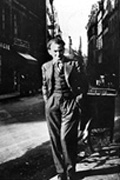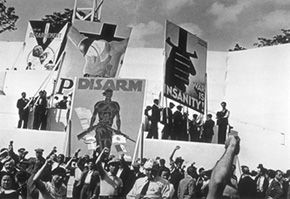
A young Chim. Paris, circa 1934. Photographer unknown.
�1996 from the Estate of David Seymour

The International Writers Congress: Paul Vaillant-Couturier, Andr� Gide, and Andr� Malraux in front of a poster of Maxim Gorki. Paris, 1935
�1996 from the Estate of David Seymour

Front Populaire Demonstration. Paris, 1936
�1996 from the Estate of David Seymour

Anti-war rally. St. Cloud. Paris, 1936
�1996 from the Estate of David Seymour
|
A new magazine was being launched in France, that became a perfect
vehicle for David Seymour's work. Like the magazine's editors, he
was an intellectual and a humanist with a social conscience. Indeed,
his values had been partly formed by their writings, which, in turn,
influenced his photographic style and writing. On board of directors
was Romain Rolland, whose novels of idealistic young men were the
rage in the 1930s, as were the books and values of pacifist Henri
Barbusse, also on the board. Another board member was the young
Andr� Malraux, who had recently won the Prix Goncourt for his La
Condition Humaine.
Like other magazines, Regards featured politics, entertainment,
sports, and serialized novels. But its specialty was to create
awareness of the deplorable economic and social conditions of the
working people of France, whose wages had been cut in recent years.
Chim reported on the coal miners at work below ground in the
Alsace, on board a tuna fishing vessel in the North Sea, on the
picturesque but hard life of the people of the remote Isle de Sein in
Brittany. In St. Etienne he showed France's finest gun makers at work
and the artisan ribbon makers, weaving fine patterns on jacquard
looms. He traveled in the company of a writer, for his work was
accompanied by articles describing the working conditions of his subjects. In Chim's work, we see his finely developed sympathy for
his subjects and his knack for photographing them unawares, abetted
by the use of his Leica, which was still very unusual among
photographers, especially in the French countryside.
Chim's work for Regards coincided with a two-year period of
mass demonstrations and mass meetings, pro and contra French
governments, pro and contra armament and disarmament, pro and
contra fascism and communism. This activity culminated in the
victory of the movement known as the Front Populaire. Regards
advocated the platform of the Front Populaire, a coalition of socialist
and communist parties, under the leadership of Leon Blum, who was
to become prime minister. This coalition was motivated not only by
the social conditions in France, but also by the fear of yet another
war with Germany next door, and, not least, as the economy
worsened and unemployment rose, by the threat of ever-growing
fascist parties at home. As prime minister, Blum accorded the French
people a new deal of their own, inspired by that of American
president Franklin D. Roosevelt. For the first time, working French
enjoyed the right of collective bargaining, and the right to a forty-
hour work week, and the right to a paid vacation. There were
adequate pensions, and government subsidies for families with many
children as well. There were other reforms to stabilize France's
financial position, plus a strong anti-fascist and pro-peace stand.
With its pro-union policy and its far-reaching contacts all over
France, Regards offered Chim a unique opportunity to photograph the
working class, whose labors provided the bulk of France's national
income at a time when working conditions and politics merged before
the twin threats of economic and political repression.
When international luminaries from the writing world met in
1935 in Paris for "Days in Defense of Culture" Chim photographed
them brilliantly. Among them were Andre Gid�, Andr� Malraux, Aldous
Huxley, and Alexis Tolstoy.
The writers, though few in number, were the most powerful
purveyors of information to influence the worker's vast numbers of
votes. The writers were responding to the threatening political
initiatives by the new fascist regimes. In March 1934, Hitler had
marched into the demilitarized zone of the Rhineland. The following
March, he introduced conscription. Italy invaded Ethiopia that
October. Yet neither England, nor France, nor the League of Nations
attempted to stem these aggressive acts. The drums of war were not
far away.
- Inge Bondi
� 1996, Inge Bondi
from CHIM: The Photographs of David Seymour, Bulfinch Press/Little, Brown and Company
|





































